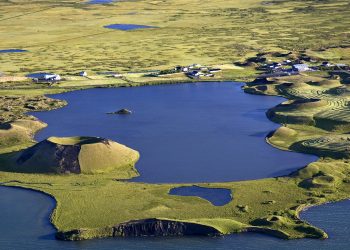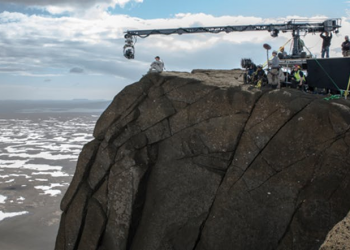With the rise of the new industry known as “ecotourism”, Iceland has become one of the world’s most popular destinations for getting in touch with nature. From its volcanoes to the Northern Lights, there is always something awe-inspiring to witness in Iceland.
One of the most popular eco-attractions are the famous black sand beaches. Here’s a handy guide on why they have their distinctive color as well as some of the most popular black sand beaches in Iceland.
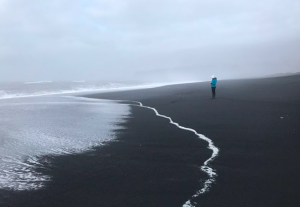
Black Sand
Black sand is common in areas with high volcanic activity. They get their color from the minerals in the volcano, as well as from lava fragments. In terms of actual mineral content, the most common mineral found in black sand is usually basalt, which is formed by the rapid cooling of lava. Nearly 90% of all the volcanic rock on the planet is basalt. The high concentration of iron in basalt also gives it its black color, as iron absorbs a lot of light.
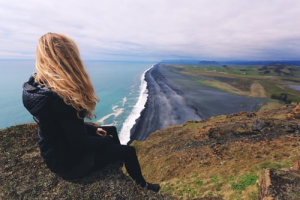
Beaches with black sand
Generally do not weather well, meaning that the basalt continues to break down as exposed to the weather. This is in contrast to standard beaches, where the mineral grains are more resistant to weathering.
Exercise Safety Measures at the Beaches!
A word of caution before we get into it, though- visitors are advised to stay about 100 feet away from the shoreline of the black sand beaches. Some waves occasionally crash which are much bigger than the other waves. These are known as sneaker waves, and they can reach much farther up the shore than you would expect. There is no land between the Arctic and Iceland, meaning that waves have miles and miles of buildup before they finally crash. Visitors are also advised to never face away from the ocean, so that you can always keep an eye on the water.
Always mind the weather!
When the weather gets bad, the black sand beaches get even worse. Violent winds can kick up the black sand, pelting you and stinging your skin. The waves get more violent with bad weather as well. If the weather takes a turn for the worse, it’s probably best to not go down to the beach that day. Beyond this, make sure to wear appropriate clothing, especially if you’re going in the winter. It can get very cold and wet, which is a bad combination, so be sure to have waterproof shoes and socks. Windburn may also occur, so having a good windbreaker can do wonders for protecting yourself from the harsh winds.
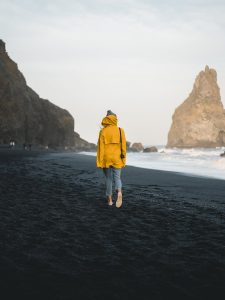
Black Sand Beaches in Iceland- Most popular sites
Reynisfjara is considered THE black sand beach in Iceland, with its distinctive sand, enormous columns of basalt, and massive waves crashing into the shore. The basalt columns are so strange looking that they were used for a few episodes of Game of Thrones! Traditional folklore says that the giant basalt stacks were once trolls trying to pull ships to the shore, but when the sun rose, the trolls turned to stone. They are truly a marvel to look at, and pictures do not do them justice.
Beyond that, though, wildlife is pretty common at Reynisfjara. The basalt stacks are home to several species of seabird, all of which nest in the columns. These include puffins, guillemots, and fulmars- be sure to keep an eye out for them! Reynisfjara is about 112 miles from the capital, Reykjavik, meaning you can plan a day trip if you so choose. The beach is rather accessible, and is right next to the small fishing town of Vik. Iceland is connected by one main highway known as the Ring Road, making travel convenient all around the island. Reynisfjara is located right alongside the Ring Road, making this stop relatively easy and overwhelmingly worthwhile.
Solheimasandur is a particularly unique black sand beach, as it has become famous for the wreckage of a plane crash that occurred there in the 1990’s. It, too, is along the Ring Road, between Reynisfjara and Reykjavik. However, visitors are no longer allowed to drive directly to the crash site- a four mile hike over the rocky sand is required to get a good look at it. Make sure to get there early, so you don’t lose daylight! Beyond the beautiful beach and the wreckage of the plane, Skogafoss Waterfall is very near the crash site, so you can get a two-for-one by hiking out to the gorgeous waterfall as well.
Dyrholaey is a large cliff that overlooks the black sand beach, giving you a unique birds’ eye view of the waves crashing into the shore. It is conveniently located very near Reynisfjara, meaning you can plan multiple spots on a day trip along the Ring Road! The cliff also features a lighthouse that you can explore and take pictures with. Like the aforementioned Reynisfjara, puffins often nest there during the warmer months, so keep an eye out for them if that’s when you’re there.
Stokksnes Beach is another amazing and unique beach in Iceland, but getting there can take some time, so plan accordingly. It is six hours from Reykjavik on the east coast of the island. The beach itself is very accessible, though, so long as you have money to get through the gate. One benefit of its out-of-the-way location is that there aren’t very many tourists, so if you can get there, you’ll have the beach (mostly) to yourself.
Situated on the Stokksnes Peninsula, an enormous mountain meets the sea right on the black sand beach, making for some incredible pictures and views. Green tufts of grass sprout up from the black sand, and the beach gets incredibly dark at night, making it an excellent viewing spot to see the Northern Lights. A truly magical place that you must see to believe, making your way to the east coast of Iceland is well worth it just for this- but there’s plenty of other great stuff there, too!
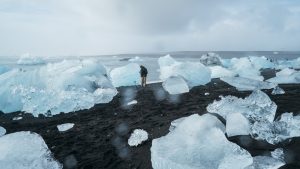
Diamond Beach is also located on the east coast, about 45 minutes from Stokksnes. Situated right next to Jokulsarlon Glacier Lagoon, the beach gets its name from the calved glaciers that wash ashore- they look like diamonds against the black sand. You can watch the massive glaciers calve and wash ashore from the Lagoon across the street, and witness the tide carry the bits of a glacier in and out of the shore. The chunks of ice can range from around a foot long to the size of a person! There’s plenty to see at Diamond Beach, and it also makes for a great photo opportunity !



